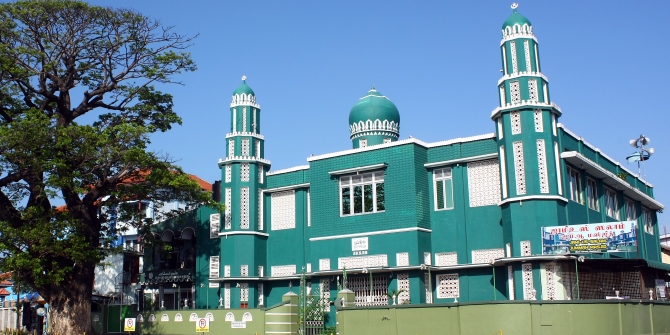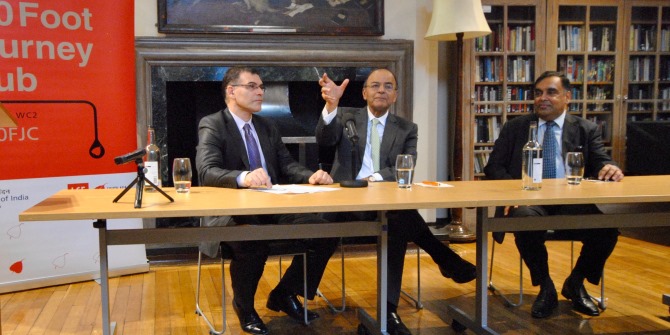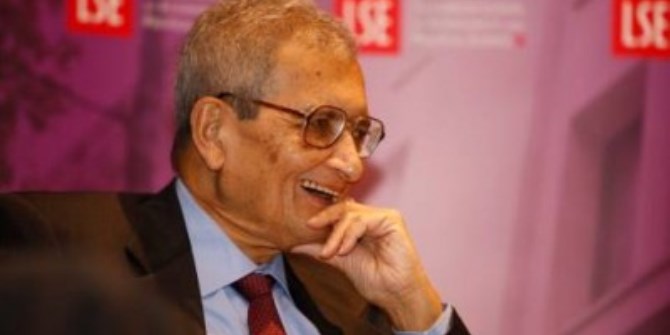 Following the Grand Alliance victory in Bihar, Maitreesh Ghatak considers whether the election was contest between the “good” causes – Nitish and Modi’s alternative models of development – or that of the “bad” causes like cows versus caste. He emphasises that the BJP-led alliance minus Nitish Kumar won a decisive victory in the national elections last year, suggesting inclusive development remains the primary concern among voters.
Following the Grand Alliance victory in Bihar, Maitreesh Ghatak considers whether the election was contest between the “good” causes – Nitish and Modi’s alternative models of development – or that of the “bad” causes like cows versus caste. He emphasises that the BJP-led alliance minus Nitish Kumar won a decisive victory in the national elections last year, suggesting inclusive development remains the primary concern among voters.
The BJP’s fate in the Bihar elections brings to mind a Bengali word go-hara which means “abject defeat” (literally “defeated like cows”). Given the salience of cows as an election issue by the BJP, the word does acquire an interesting twist in light of its crushing defeat! Did the BJP lose because the Bihari voters rejected cow-politics, or more broadly, all the divisive social issues that BJP harped on – the so-called polarisation strategy – and chose instead the good-governance model of Nitish Kumar? Or, is it true as some commentators on the right are lamenting, that the Mahagatbandhan (MGB) has won because Bihar has rejected the development agenda of Narendra Modi for the caste-based politics of Lalu Yadav despite the jungle-raj that is associated with his (and later his wife’s) rule of Bihar?
It is quite common for a party, if it wins, to highlight the “good” reasons behind its victory and for the opponents to point out the “bad” reasons for it. If the results went the other way, both sides would very likely have changed their tunes. The MGB would have said that BJP’s communal polarisation strategy drowned out Nitish Kumar’s good governance agenda, and the BJP would have said Modi’s development-model triumphed over caste and criminality in politics.
So was it a mainly a contest between the “good” causes – Nitish and Modi’s alternative models of development – or that of the “bad” causes like cows versus caste?
The story is complicated by two factors. First, the BJP was the major partner of the coalition headed by Nitish Kumar that ruled Bihar for almost a decade successfully until the break up two years ago. Second, the turnaround in Bihar under Nitish Kumar’s leadership is with respect to the poor performance of Lalu’s RJD that ruled the state almost continuously for the previous decade and a half. Even if Nitish Kumar’s party did not have enough seats to get a majority in 2010 and does not have it now, there is no question that in the last two elections he was like the star who helps a film to be a hit even though his co-stars may change or in some cases, get more screen time! That may be unfair to Sushil Modi, the Deputy Chief Minister when JDU and BJP were in alliance, or to Lalu Yadav, undoubtedly a major force in the current election campaign, but that’s the way it is. Those who are saying the RJD got more seats than JDU are forgetting that Nitish Kumar was firmly projected as the Chief Ministerial candidate all through the campaign by the MGB, in sharp contrast to the BJP which did not project a Chief Ministerial candidate. Nitish Kumar was the brand that was being marketed by the MGB, and the BJP’s counter-strategy was the brand of Narendra Modi, undoubtedly the biggest factor behind the BJP’s resounding win in last year’s national elections.
If we take the clash of the two brands of Development, Narendra Modi vs Nitish Kumar, what does the experience of the states they ruled tell us? In a study of the growth performance of Gujarat and Bihar under Modi and Nitish Kumar with Sanchari Roy I found that while Gujarat indeed had the highest growth rate of income among Indian states while Modi was Chief Minister, its growth rate relative to India was similar in the decade preceding Modi’s rule. In contrast, Bihar’s growth rate relative to the rest of the country under Nitish Kumar did indeed significantly change compared to the earlier regime. Therefore, if there was a prize for turnaround of a state’s economic fortune, that should have gone to Nitish Kumar, not Modi.
Now, one may argue that it is easier to turn around a state that was at the bottom of the league like Bihar than to maintain, or to marginally improve, the performance of a state already at the top, like Gujarat. After all, there is greater scope for improvement in the former case. Conversely, one could also argue that it is more challenging to turn around a backward state, because if it were easy, someone would have done it already.
The growth experience of both states, however, raises the question as to what extent the benefits of growth have trickled down to the poorer sections of society. Indeed, if one looks at the Human Development Index for different states, Gujarat is marginally above the Indian average in the decade before and after Modi, even though its growth performance was impressive. The fact that Gujarat’s performance in measures of human development is not in line with its rank in terms of the level and growth rate of average incomes has been noted by many, including the 2013 report of the Raghuram Rajan committee. In contrast, while Bihar remains below the Indian average, its rate of improvement was faster over comparable periods.
This suggests that Nitish Kumar’s performance in terms of delivery of social services to the poorer sections – for example, the well-known bicycle programme for girls going to school, improvements in roads and electricity – has been a more inclusive development-model than that of Gujarat. But it was not just the Bihar vs the Gujarat model that was at play in this elections. The voters of Bihar did vote for Modi as PM in last year’s elections. Therefore, this is also a reflection of the disappointment that has set in with the Modi government at the Centre. If there was a real economic turnaround after the Modi government came to power in the Centre (as opposed to statistical adjustments of the growth rate) or prices of essentials had come down, the situation may have been different.
Those who are lamenting that Bihar politics is all about caste miss out two important points. In the national elections in May last year, the BJP-led alliance minus Nitish Kumar won a decisive victory – if those trends were maintained it should have won 172 seats, instead of the measly 58 it received. Was caste not a factor last year? The fact is, the Bihari voter did vote for the BJP last year in the national elections and the “good” cause of Modi’s Gujarat model played a big role then.
Also, caste and class are highly correlated in the Indian context. While there is variation within all caste groups, there is no doubt that Dalits, Other Backward Castes, and Adivasis are on average considerably poorer than forward castes as many studies show. There may be genuine grounds for debating the reservation policy in India as I myself have argued earlier, but to dismiss them as a reflection of a traditional caste-oriented outlook ignores the reality of both caste-discrimination and distributional concerns of the poorer sections. It is not accidental that according to preliminary reports, the BJP’s loss was particularly heavy in rural areas, where the poorer sections live.
It once again comes back to the question of inclusive development, or sabka saath, sabka vikas. A slogan worth repeating until the cows come home. That is the real lesson of the Bihar elections.
This article originally appeared on NDTV.com on 9 November 2015. It is reposted with the author’s permission.
Cover image credit: Narendra Modi/Wikicommons CC BY-SA 2.0
Note: This article gives the views of the author, and not the position of the South Asia @ LSE blog, nor of the London School of Economics. Please read our comments policy before posting.
About the Author

Maitreesh Ghatak is Professor of Economics at the LSE. He is Lead Academic on the IGC India-Bihar country team and Economic Organisation and Public Policy Programme Director at STICERD.
Maitreesh is a regular contributor to the South Asia @ LSE blog. View previous posts here.







